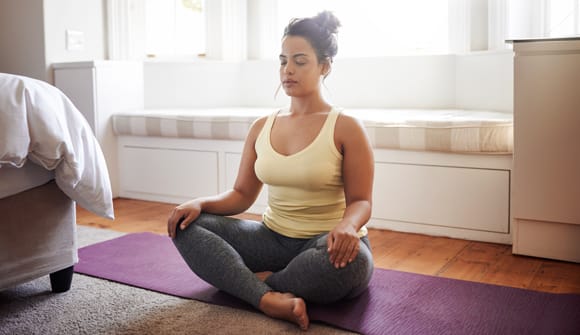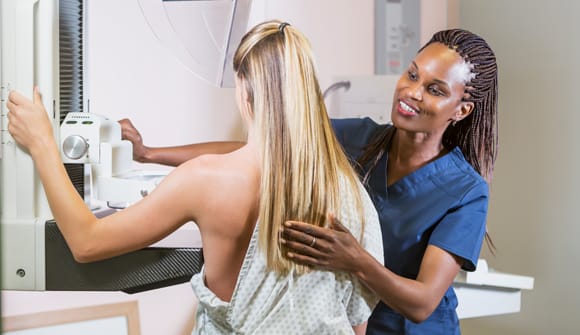Fit with your period
Exercising in sync with your menstrual cycle.
Article Date:

There are days when we don’t feel like working out and we blame it on Aunt Flo, but what if our fitness success is actually connected to our menstrual cycle?
The hormonal changes in our bodies throughout the month can affect our energy and fitness results. That’s why some mornings we’re ready to bike for miles and other days we’re barely busting out of bed. We’re constantly riding the waves of our fluctuating hormones.
Listening to our bodies can help us plan when to sweat and when to take breaks.
“Every human has a circadian rhythm, which is related to physical, mental and behavioral changes that follow a 24-hour cycle of light and dark. But women have another biological clock, called the infradian rhythm, which is related to our menstrual cycle,” said Lisa Bradford, RN, the nurse wellness coach with the Baptist Health 4her program, which offers wellness services throughout every stage of a woman’s life. “The infradian rhythm can affect the body’s processes such as metabolism, energy and cortisol levels at different points in the month.”
Phases of fitness
There are four phases of the menstrual cycle: menstrual, follicular, ovulation and luteal. Women have different hormone levels at each phase.
“Understanding your current phase is important because the fluctuating hormones impact your body’s vitality. Some women report low energy levels during their period, while other women have more than usual during this time,” said Bradford. “The physical and mental benefits of exercise don’t stop because you have your period. Sticking with a routine can help ease some of the common complaints that accompany menstruation.” You may want to vary the intensity and frequency of your workouts based on how your hormones fluctuate during each phase.
- Menstrual: Estrogen and progesterone levels are at their lowest during the shedding of the uterine lining, or when you first get your period (usually days 1-6 of the cycle). However, they begin a gradual rise during your period. It may feel easier to be active than in previous weeks, but light to moderate movement is best. Restorative yoga, walking and stretching can help offset menstrual symptoms like pain and bloating.
- Follicular: In the week after your period ends, your energy levels may increase. Estrogen levels begin rising quickly in preparation for ovulation. Light cardio exercises, such as barre, yoga, Pilates and walking are great workout options.
- Ovulation: Estrogen levels peak around the time of ovulation (the release of an egg), about two weeks before the next period for most women. When estrogen levels fall quickly after ovulation and progesterone levels begin rising, you may feel more tired or sluggish than usual. This does not mean that you should not exercise. In fact, being active might help boost your mood and give you more energy. During ovulation, try short, high-intensity exercises first thing in the morning, before your energy level goes down as the day goes on.
- Luteal: In the week before your period, you may feel less energy as both estrogen and progesterone levels are falling (if you’re not pregnant). Light to moderate physical activity may improve premenstrual symptoms (PMS) like mood changes, headaches, acne, bloating and breast tenderness, even if your energy levels are low. “Many women notice bloating or weight gain during this phase, but will lose the excess weight once the next period begins,” said Bradford. “Try to avoid or limit fatty and salty foods, alcohol and caffeine during the luteal phase.”
Workout plan
Regular exercise is beneficial for your body and your mind even during your period, said Bradford.
“Continue with exercise, but back off on the intensity, especially if you’re feeling fatigued. Vary your workouts and take extra time to recover,” she explained. “Matching your life with your cycle helps you avoid burnout and keeps you mindful every day of your body’s needs.”
Bradford offered additional wellness tips for your 28(ish) days and beyond.
- Keep a fitness journal to track your menstrual cycle and your energy levels during each workout. After a few months, you’ll see when you have more and less motivation.
- Try using a menstrual cycle tracking app to better understand your body’s unique needs.
- Allow yourself time off when you feel tired.
- See if you can schedule harder workouts, competitions and races during your ovulation phase, when your energy levels might be higher.
Be aware if you’re taking hormonal birth control, like the pill, patch, shot or a vaginal ring, your energy levels may still vary with your cycle, but the differences may not be as noticeable.
The Baptist Health 4her program is a unique collection of wellness resources for women of all ages. You can book a health coaching session with Lisa Bradford to talk about your health goals and needs by calling 904.202.4HER or emailing 4her@bmcjax.com.



